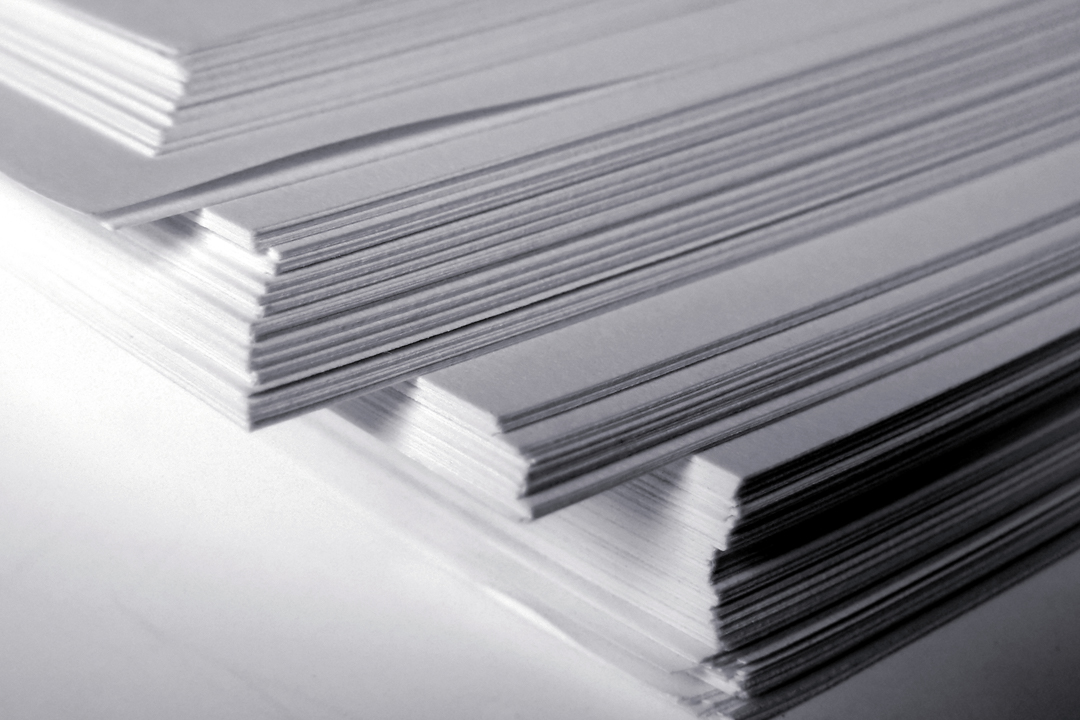Show of hands – who gets confused when looking at paper sizes and codes? Trust us, you’re not alone. With so many choices available, different paper sizes, finishes, and weights can be baffling at times.
Choosing the correct paper is fundamental to making an impact with your designs. Squeezing an unbelievable amount of detail onto your artwork on-screen might be possible, but the result won’t look so hot once it’s printed onto an A8 flyer. To help you understand the basics, we’ve created this comprehensive guide to paper and paper sizes.
GSM: What does it stand for?
GSM, or grams per square meter, is the measure of the weight and overall quality of the paper. Generally, the higher the GSM number, the heavier and of higher quality the paper is. Here’s a rough guide to GSM sizes:
| Item | GSM paper weight |
| Printed paper | 80 – 100gsm |
| Posters | 130 – 350gsm |
| Flyers and leaflets | 130 – 350gsm |
| Brochures | 130 – 250gsm |
| Greeting Cards | 350 – 400gsm |
| Letterheads | 100 – 170gsm |
| Business Cards | 400 – 810gsm |
As you can see, there’s a big difference in weights and that’s something you need to consider when taking your designs to print. To find out more about GSM, take a look at our quick guide.
Paper finishes
Weight is important, but we believe the finish of paper is equally vital and can have an impact of its own if chosen correctly. Here are a few of the most common types:
- Matt: A matt finish is your standard printer or notepad paper texture, meaning you can write on it, but it won’t have the shiny, smooth effect that gloss does.
- Gloss: A high shine and sharp colours are yours to enjoy when you pick a gloss finish.
- Silk: This type is widely used, as it has a gloss-like texture that still allows for your scribbles.
- Spot UV: This varnish-effect is perfect for business cards and can be applied to certain areas of the card (logos are a good example) to create the appearance of a richer colour in that area.
Different paper sizes
A paper sizes: A-sized paper is commonly used for general printing and stationery. Examples include:
- Leaflets, ranging from A3 to A7 in size
- Business cards
- Brochures, varying from A4 to A6 prints
- Posters, again ranging in size from A0 to A4
B paper sizes: B-sized paper, on the other hand, are usually the preferred choice for larger posters, which can be provided in B1 or B2 size.
C paper sizes: Finally, C-sized paper i.e: C4. C5, C6 are normally used for envelopes, whose purpose is to contain A-sized paper documents.
Understanding paper sizes
The best thing about the system is how simple it makes it to calculate different paper sizes. If you divide a piece of paper into equal halves along its longest sides, then each half is in the same proportion as the original. It means folded brochures of any size can be made using sheets of the next larger size. E.g. A4 paper sheets are folded to make A5 brochures.
The three ISO standard paper sizes each have different sizes within their categories. In each category, the full sheet is designated by the number 0. For example, in the case of A, this would be A0, sized 814mm (w) x 1189mm (h), or one square meter in area. The longer length is then halved to give 1, then halved again to give 2. Therefore, A4 is half of A3.
To help you understand the system better, we’ve created a simple paper size chart below that lists the dimensions of different A paper sizes in cm, inches and mm.
| Size | Width (mm) x Height (mm) | Width (in) x Height (in) | Width (cm) x Height (cm) |
| A0 paper size | 841 x 1189 | 33.1 x 46.8 | 84.1 x 118.9 |
| A1 paper size | 594 x 841 | 23.4 x 33.1 | 59.4 x 84.1 |
| A2 paper size | 420 x 594 | 16.5 x 23.4 | 42 x 59.4 |
| A3 paper size | 297 x 420 | 11.7 x 16.5 | 29.7 x 42 |
| A4 paper size | 210 x 297 | 8.3 x 11.7 | 21 x 29.7 |
| A5 paper size | 148 x 210 | 5.8 x 8.3 | 14.8 x 21 |
| A6 paper size | 105 x 148 | 4.1 x 5.8 | 10.5 x 14.8 |
| A7 paper size | 74 x 105 | 2.9 x 4.1 | 7.4 x 10.5 |
| A8 paper size | 52 x 74 | 2.0 x 2.9 | 5.2 x 7.4 |
FAQs
Our inboxes are always crammed full of questions about B5 paper sizes, paper quality and business card thickness, among many other things. To make things a little easier, we’ve compiled the most common queries we receive:
What is the smallest A paper size available?
The ISO A series paper sizes begin with the smallest – A8, which is 52mm (w) x 74mm (h). These are the standard size for bank cards and driving licenses, so consider the scaling and size you have to work with when choosing A8 paper.
What is the difference between a flyer and a leaflet?
The difference between the two is the type of paper stock used to create them. A leaflet is printed on paper, whereas a flyer is printed on card, therefore giving them a difference in paper thickness and weight.
How thick are each of the layers on your triple layer business cards?
All three layers on MultiLoft cards that we offer are 270gsm thick. Combining all three gives a total thickness of 810gsm.
If you have any further questions about paper sizes, weights or finishes don’t hesitate to get in touch with our team. We’re here to help you create the best-printed products for your business.





Exactly, C-sized paper i.e: C4. C5, C6 are normally used for envelopes, whose purpose is to contain A-sized paper documents.